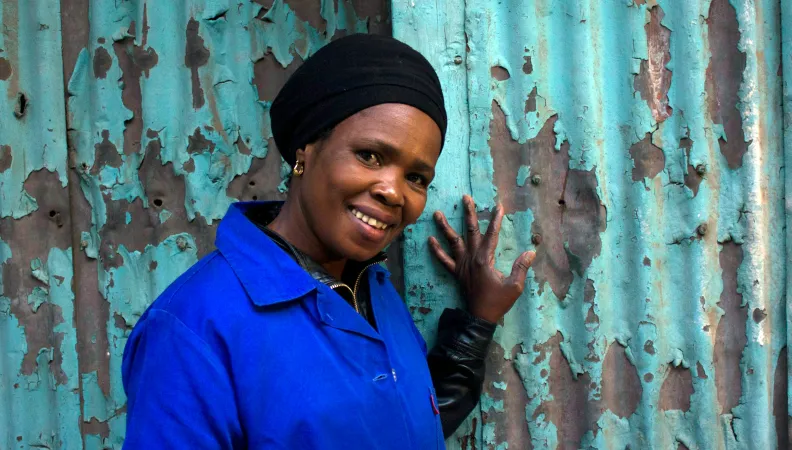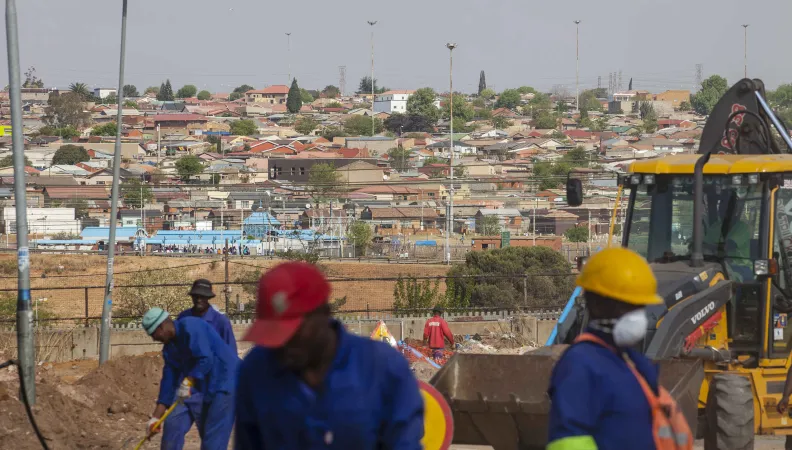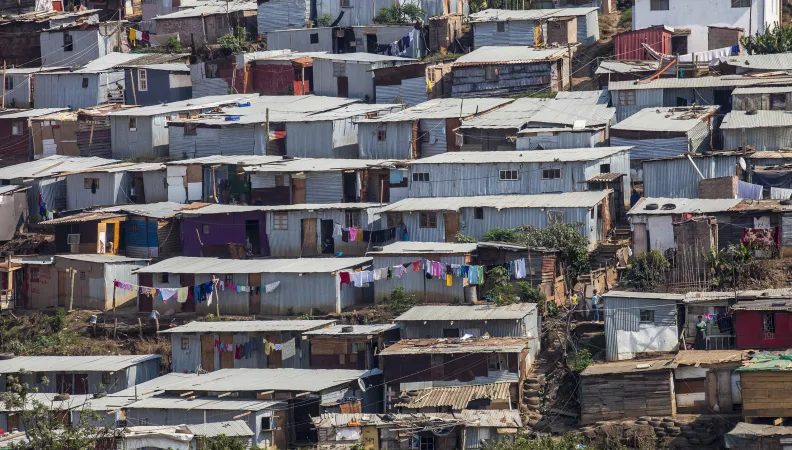 Extreme weather events resulting from the effects of climate change coupled with a global call for countries to reduce their greenhouse gas (GHG) emissions imply that the transition to a “green” economy is non-negotiable. The societal and policy discussions have moved on to trying to understand the transition possibilities and the economic and social implications of these in each country’s context. This research project will focus on the case of South Africa.
Extreme weather events resulting from the effects of climate change coupled with a global call for countries to reduce their greenhouse gas (GHG) emissions imply that the transition to a “green” economy is non-negotiable. The societal and policy discussions have moved on to trying to understand the transition possibilities and the economic and social implications of these in each country’s context. This research project will focus on the case of South Africa.
Context
South Africa is one of the largest GHG emitting countries due to its heavy reliance on coal for most of its energy needs. The South African government is cognisant of the fact that shifting away from carbon-intensive forms of technology to more sustainable ways of production means that some jobs will be destroyed, and new ones will be created. A concern therefore for policy makers is ensuring that the transition is just and that it will not exacerbate existing inequalities.
South Africa comes into this employment transition discussion facing a triple challenge: persistent high unemployment, inequality, and poverty. This situation has worsened since the 2007-2008 financial crisis and was further exacerbated by the recent COVID-19 pandemic. This complicates the discussion of an optimal social transition to a “green” economy.
This project is part of a wider research program on the just transition in South Africa, conducted with several South African research centres and in close collaboration with the South African authorities.
See also: Research on inequalities
Goal
The project will carry out a study of the South African labour market with the aim of identifying the proportion and distribution of workers engaged in “green” jobs and “brown” jobs – in other words, jobs that are ecologically sustainable and jobs that are not. It will also examine the possibilities of transitioning labour from brown jobs into low emitting sectors.
Method
We will measure green intensity as the share of total tasks in an occupation that are green. We will also identify the share of workers in green jobs using employment information from surveys such as the Quarterly Labour Force Surveys (QLFSs) and the Census. Using industry level information on pollution, we will go further to identify occupations more likely to be in highly polluting sectors than in any other sectors. This will be described as brown jobs. Next, we will utilise occupational tasks, skills, and knowledge information from the O*NET dataset to identify important skills for brown and green jobs. This will enable us to estimate the probability of transitioning workers to green jobs. Finally, to map the location of green jobs, we will use employment information from the Census, the Community Survey, and the Spatial Tax data.
Contact:
- Anda David, research officer, AFD
 Legal notice EU (project) How could the Social Relief Distress grant be redesigned to maximize impact on poverty and unemployment reduction, while being sustainable in the longer term? The Extension of the EU-AFD Research Facility on Inequalities will seek to answer this question in partnership with SALDRU (University of Cape Town – Southern Africa Labour and Development Research Unit).
Legal notice EU (project) How could the Social Relief Distress grant be redesigned to maximize impact on poverty and unemployment reduction, while being sustainable in the longer term? The Extension of the EU-AFD Research Facility on Inequalities will seek to answer this question in partnership with SALDRU (University of Cape Town – Southern Africa Labour and Development Research Unit).
Context
South Africa’s Economic Reconstruction and Recovery Plan was launched in October 2020 by the Presidency in response to the economic impacts of the Covid-19 pandemic. Besides the Presidential Employment Stimulus program, it included emergency social protection measures, among which the introduction of a special Covid-19 Social Relief of Distress grant (SRD), providing ZAR350 per month for unemployed people not covered by any other form of support. The South African government now seeks to develop options for the future of SRD grant.
This project is part of the Extension of the EU-AFD Research Facility on Inequalities. Coordinated by AFD and financed by the European Commission, the Extension of the Facility will contribute to the development of public policies aimed at reducing inequalities in four countries: South Africa, Mexico, Colombia and Indonesia over the period 2021-2025.
Objectives
The objective of this research project is to produce motivated recommendations on how the SRD should be designed going forward into the longer term, in order to maximize the impact of the grant on employment outcomes and to ensure it effectively reduces poverty, while maintaining its cost to an acceptable level:
- To maximise the impact of the grant on employment, the project needs to understand how to design and label the grant to encourage its use for job search.
- To ensure the grant effectively reduces poverty, the project must figure out the most cost-effective way to target and assess the eligibility of recipients. Moreover, poverty reductions can be scaled up by determining measures that could encourage take up among the most disadvantaged.
Once these goals have been achieved, and in order to inform public decision-making, these findings must be communicated to a number of stakeholders in government and civil society.
This project is part of a wider research program conducted with several South African research centres and in close collaboration with the South African Presidency. Four other research projects analysing the externalities of the Covid-19 stimulus policy are currently being developed as part of the first pillar of the Extension's activities in South Africa.
Method
This research project uses the model generated to conduct the 2014/2015 fiscal incidence assessment and introduces updated data for 2019-2021. It simulates five scenarios around eligibility criteria, targeting mechanisms, value, disbursement model and conditionalities and computes the potential impact on poverty and employment outcomes.
Research findings
You will find below the research paper related to this project:
It is worth noting that another paper has been published on the implications of the SRD grant, funded by AFD outside the Research Facility on Inequalities: Systemic exclusion from a South African social assistance transfer (February 2024)
 AFD and the Economic Research Forum (ERF), in collaboration with the Egyptian Central Agency for Public Mobilization and Statistics (CAPMAS), are supporting the implementation of the fifth wave of the Egypt Labor Market Panel Survey (ELMPS). This new wave of the ELMPS survey aims to highlight the evolution of the Egyptian labour market, economy and society and thus provide essential data to analyze the effects of public policies in Egypt.
AFD and the Economic Research Forum (ERF), in collaboration with the Egyptian Central Agency for Public Mobilization and Statistics (CAPMAS), are supporting the implementation of the fifth wave of the Egypt Labor Market Panel Survey (ELMPS). This new wave of the ELMPS survey aims to highlight the evolution of the Egyptian labour market, economy and society and thus provide essential data to analyze the effects of public policies in Egypt.
Context
Labour market panel surveys (LMPS) are household surveys that allow to observe the evolution of labour market dynamics by following the same individuals over several years. Conducted in Egypt in 1998, 2006, 2012 and 2018, these surveys have become the focus of research on the labour market, human development, migration, the (de)composition of families and social protection. They make it possible to analyse the impacts of the various tax and monetary reforms undertaken in the country. The data also sheds light on the opportunities and challenges women face in the labour market.
Goal
This research partnership supports the implementation of the fifth wave of the ELMPS survey in Egypt by providing co-financing dedicated to data collection and dissemination. The objective of this collaboration is to support the production of the wave, as well as presentation chapters of this wave, four of which will be published as research papers to deepen knowledge on the Egyptian labour market. Particular attention will be paid to the analysis of the labour market situation in Egypt following the Covid-19 pandemic, thus providing relevant insights in this post-pandemic context.
Method
The new ELMPS 2023 wave is largely based on the questionnaire of the 2018 ELMPS survey, which addressed issues such as demography, employment, income, migration and well-being.
This edition differs from previous editions in several ways:
- It incorporates questions dedicated to assessing the impact of the Covid-19 pandemic;
- It broadens its coverage by including new components, such as the digital economy (gig economy) and employment measurement in the emerging green and circular economy sectors;
- It provides for a skills-based module, with the inclusion of a wider variety of skills, which will assess the extent to which workers' skills match the needs of the labour market.
These improvements are intended to ensure more comprehensive and representative data, thus providing a solid foundation for informed public policy development.
Results
The ELMPS 2023 database will be made available on the ERF website.
Research papers will focus specifically on:
- The role of internal migration in territorial dynamics;
- The evolution of the insurance system and its coverage;
- Technology in the labour market and its use;
- The green economy and the labour market.
A book will be published covering the themes of 1) labour supply; 2) employment structure; 3) inequalities; 4) mismatch between labour supply and demand; 5) gender and occupational segregation; 6) international migration; 7) social protection; 8) technology in the workplace; 9) green economy; 10) small and medium-sized enterprises (SMEs); 11) care activities (paid and unpaid); 12) food security and resilience to shocks.
Contacts:
- Dr. Cecilia Poggi, Research Officer, AFD
- Prof. Ragui Assaad, Humphrey School of Public Affairs, University of Minnesota
 How can we better understand local realities and more particularly socio-economic outcomes at the community level? The Extension of the EU-AFD Research Facility on Inequalities in partnership with the Southern Africa Labour and Development Research Unit (University of Cape Town), and in close collaboration with local and national government entities, seeks to answer this question.
How can we better understand local realities and more particularly socio-economic outcomes at the community level? The Extension of the EU-AFD Research Facility on Inequalities in partnership with the Southern Africa Labour and Development Research Unit (University of Cape Town), and in close collaboration with local and national government entities, seeks to answer this question.
Context
South Africa’s spatial inequality translates in significantly different lived experiences among members of different communities across the country. Statistics South Africa gathers data on a range of socio-economic outcomes of individuals and households through an array of national surveys; these data can be analysed at the national, provincial, district and sometimes municipal level, and provide us with a sense of well-being, deprivation and inequities in these, between these different geographies. However, there is not yet one standardised set of data that would allow for a coherent, systematic and longer-term understanding, visualisation and tracking of a broad set of indicators on well-being, that allows for a better understanding of socio-economic outcomes at the community level. Yet, understanding this local context is important, as it is within that local reality that policies and interventions aim to make a difference. South Africa’s government has recognised this too and, with the introduction of its District Development (DD) Model, aims to see different spheres and departments of government work together for larger impact, “higher performance and accountability for coherent service delivery and development outcomes”. A consolidated, central point of information that is accurate and regularly updated, would provide a strong basis for the implementation South Africa’s DD Model.
This project therefore proposes the development of an interactive, online Community Explorer that would allow researchers, policy-makers and civil society members to build a stronger understanding of well-being at the community (or main area) level in South Africa. Such an understanding is crucial to inform development efforts implemented at that community level. We suggest drawing on the local level information for the Steve Tshwete municipality to pilot the Community Explorer approach.
The local municipality of Steve Tshwete is part of the Mpumalanga province, an area that is home to one of the country's largest coal mining areas and accounts for 83% of the coal produced in South Africa. Steve Tshwete can be considered as one of the commercial centers of this province, with one of the largest local economies in the district dominated by the mining, manufacturing and financial sectors. As such, coal mining and the three coal-fired power plants currently in operation are by far the largest contributor to local employment, accounting for 40% of it.
This project is part of the Extension of the EU-AFD Research Facility on Inequalities. Coordinated by AFD and financed by the European Commission, the Extension of the Research Facility will contribute to the development of public policies aimed at reducing inequalities in four countries: South Africa, Mexico, Colombia and Indonesia over the period 2021-2025.
Objectives
This project proposes to leverage the data and tools already available on the South African Youth Explorer (and the related WaziMap tool). The SA Youth Explorer is a SALDRU-led project that constructs and maps a range of indicators that measure key dimensions of well-being among young people, at various geographical levels. Using Census 2011 data, these indicators are currently constructed for the following domains: demographics, education, living environment, economic opportunities and youth poverty (including income poverty and multidimensional deprivation). In addition, the project has begun the construction, verification and maintenance of a central database of service provision, that allows for government-provided services to be mapped down to the main area level. Finally, it is the project’s aim to explore the possibilities of adding a third layer of knowledge with local labour market demand side information. As such, the overall aim of the proposed project is to provide “an understanding of the functionings of geographical areas as economic and social systems” and thereby “to promote the construction of an integrated and effective” approach to policy and planning that would ultimately contribute to the social betterment of all.
In addition, the project will use the administrative South African Revenue Service (SARS) and National Treasury (NT) Firm-Level (SARS-NT) Panel data developed as a joint SARS–National Treasury–UNU-WIDER initiative which gives matched employee-employer level information and thus allows computing labor market demand indicators. The greatest advantage of the administrative SARS–NT Panel data over other firm-level surveys is that it allows us to have employee-related information such as income, age and gender, as well as firm-level information such as labour costs, gross sales, industry sector, firm age, productivity, firm size, learnership and training cost . Another advantage of the administrative SARS–NT Panel data which is important for the project is that the worker and firm information can be aggregated to four different geographical levels, namely: province, district municipality, local municipality, and main place . With these geographical levels, it is possible to create local averages of various worker and firm variables that can then be mapped alongside Higher Education Institutes present at the local level.
Research findings
You will find below the two research papers related to this project:
- Developing a Youth Labour Market Index for South Africa at the sub-national level
- Youth and the just transition. A profile of young NEET in Mpumalanga

